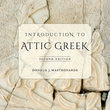| φύλαξ |
acute on first syllable of stem φῠλακ- in nom. sing. (“main form”) |
| φύλακος |
acute persists on A (= first syllable of stem) with short U |
| φύλακῐ |
acute persists on A (= first syllable of stem) with short U |
| φύλακᾰ |
acute persists on A (= first syllable of stem) with short U |
| φύλαξ |
acute persists on first syllable of stem |
| φύλακες |
acute persists on A (= first syllable of stem) with short U |
| φυλάκων |
acute moves to P (= second syllable of stem) because of long U |
| φύλαξῐ |
acute persists on A (= first syllable of stem) with short U |
| φύλακᾰς |
acute persists on A (= first syllable of stem) with short U |
| κλώψ |
acute on the monosyllabic stem κλωπ- in nom. sing. (“main form”) |
| κλωπός |
acute moves to U (genitive case – rule 4) |
| κλωπί |
acute moves to U (dative case – rule 4) |
| κλῶπᾰ |
accent on P in accusative of monosyllabic stem (rule 4); circumflex by rule 6 |
| κλώψ |
acute on the monosyllabic stem κλωπ- in nom. sing. |
| κλῶπες |
accent on P in nominative of monosyllabic stem (rule 4); circumflex by rule 6 |
| κλωπῶν |
accent moves to U and is circumflex on long vowel (genitive case – rule 4); |
| κλωψί |
acute moves to U (dative case – rule 4) |
| κλῶπᾰς |
accent on P in accusative of monosyllabic stem (rule 4); circumflex by rule 6 |
 Accentuation Tutorial
Accentuation Tutorial
